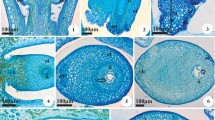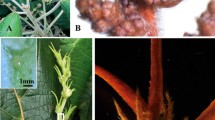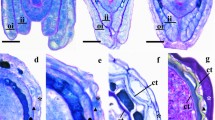Abstract
The hairs at the apical end of the seeds ofHillia are pluriseriate, multicellular structures. The cells making up a hair are elongated exotesta cells and, consequently, also have secondary thickenings identical (H. parasitica) or similar (H. costanensis) to those found on the exotesta cells on the main body of the seeds. Hair formation already starts in bud stage: at and around the chalazal region of an ovule, integument epidermis cells are grouped together to form ± elongated packets of 4–7 cells. The cells of each packet undergo further elongation and anticlinal division so that a hair on a mature seed may be up to c. 30 mm long. Basally, the seeds have a tail- to ± wing-like appendage, made up of only two cell layers, the exotesta of the ab- and adaxial side of the seed. This basal appendage shows the same anatomical structure as the wings of various anemochorous rubiaceous seeds. Although seed hairs of this kind are unique in theRubiaceae and — from the point of development and structure — not homologous to exotesta wings, the presence of a basal wing-like appendage suggests thatHillia, previously often placed into a tribe of its own (Hillieae), can be accommodated in theCinchoneae, a tribe in which winged, anemochorous seeds predominate. The tufts of hairs of the comose seeds ofHillia look superficially similar to those of certainAsclepiadaceae andApocynaceae (like theRubiaceae belonging to the orderGentianales). Comparisons based on literature data, however, reveal that there are striking differences in the position, development and structure of the hairs (produced at the micropylar end, initiated after fertilization, hairs unicellular, etc.).
Similar content being viewed by others
References
Bremer, B., 1996: Phylogenetic studies withinRubiaceae and relationships to other families based on molecular data. — InRobbrecht, E., Puff, C., Smets, E., (Eds): Second InternationalRubiaceae Conference, Proceedings. — Opera Bot. Belg.7: 33–50.
Buchner, R., Puff, C., 1993: The genus complexDanais-Schismatoclada-Payera (Rubiaceae). Character states, generic delimitation and taxonomic position. — Bull. Mus. Natl. Hist. Nat., B, Adansonia15: 23–74.
Corner, E. J. H., 1976: The seeds of dicotyledons,1. — Cambridge: Cambridge University Press.
Fukuoka, N., 1981: Studies in the floral anatomy and morphology ofRubiaceae. V:Naucleeae s.l. — Acta Phytotax. Geobot.32: 114–120.
Guignard, L., 1917: Sur le développement et la structure de l'ovule chez les Apocynacées et les Asclepiadacées. — Compt. Rend. Hebd. Séances Acad. Sci.165: 981–987.
Igersheim, A., 1993: The character states of the Caribbean monotypic endemicStrumpfia (Rubiaceae). — Nordic J. Bot.13: 545–559.
—, 1996: A simple method for microtome sectioning of prehistoric charcoal specimens, embedded in 2-hydroxyethyl methacrylate (HEMA). — Rev. Palaeobot. Palynol.92: 389–393.
Lattoo, C. S., 1974: Morphology and embryology ofHolarrhena antidysenterica Wall. — Bot. Gaz.135: 173–180.
Pearson, N. L., 1948: Observations on seed and seed hair growth inAsclepias syriaca L. — Amer. J. Bot.35: 27–36.
Puff, C., Igersheim, A., 1994: The character states ofMussaendopsis Baill. (Rubiaceae-Coptosapelteae). — Flora189: 161–178.
Robbrecht, E., 1988: Tropical woodyRubiaceae. — Opera Bot. Belg.1: 1–271.
Schumann, K., 1895:Apocynaceae, Asclepiadaceae. — InEngler, A., Prantl, K., (Eds): Die natürlichen Pflanzenfamilien4(2), pp. 109–189, 189–306. — Leipzig: Engelmann.
Struwe, L., Albert, V. A., Bremer, B., 1994: Cladistics and family level classification of theGentianales. — Cladistics10: 175–206.
Taylor, C. M., 1989: Revision ofHillia subgen.Ravnia (Rubiaceae:Cinchonoideae). — Selbyana11: 26–34.
—, 1994: Revision ofHillia (Rubiaceae). — Ann. Missouri Bot. Gard.81: 571–609.
Xifreda, C. C., 1993: Identidad deManothrix Miers. — Darwiniana32: 191–194.
Author information
Authors and Affiliations
Rights and permissions
About this article
Cite this article
Puff, C., Buchner, R. Development and structure of the comose seeds ofHillia (Rubiaceae) . Pl Syst Evol 210, 147–157 (1998). https://doi.org/10.1007/BF00985665
Received:
Revised:
Accepted:
Issue Date:
DOI: https://doi.org/10.1007/BF00985665




